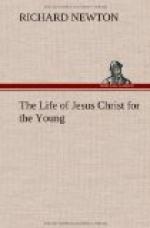And when he healed the leper it was to teach us the same great truth. This disease was not only like all other diseases, the result of sin; but, unlike most other diseases, it was a type, or figure of sin. It affected the body as sin affects the soul. And then, leprosy was a disease which none but God could cure; just as sin is an offence which none but God our Saviour can pardon. And so Jesus performed the miracle of healing the palsied man and the lepers in order to teach his disciples the great lesson that he “had power on earth to forgive sins.”
And he has the same power still. Here are some illustrations of the way in which he exercises this power now.
“No Pardon but From Jesus,” There was a heathen man in India once, who felt that he was a sinner, and longed to obtain pardon. The priests had sent him to their most famous temples, all over the country, but he could get no pardon, and find no peace. He had fasted till he was about worn to a skeleton, and had done many painful things—but pardon and peace he could not find. At last he was told to put pebbles in his shoes and travel to a distant temple, and make an offering there; and he would find peace. He went. He made the offering; but still he found no relief from the burden of his sins.
Sad, and sorrowful, he was returning home with the pebbles still in his shoes. Wearied with his journey, he halted one day in the shade of a grove, by the wayside, where a company of people was gathered round a stranger who was addressing them. It was a Christian missionary preaching the gospel. The heathen listened with great interest. The missionary was preaching from the words:—“The blood of Jesus Christ cleanseth from all sin.” He showed what power Jesus had to forgive sins and how able and willing he is to save all who come unto him. The heart of the poor heathen was drawn to this loving and glorious Saviour. He took off his shoes and threw away the pebbles, saying “This is the Saviour I have long sought in vain. Thank God! I have found salvation!”
Here is one more illustration of the way in which Jesus pardons our sins, and of the effect which that pardon has on those who receive it. We may call it:




